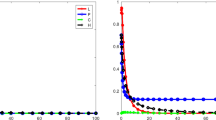Summary
The behavioural time budgets of two non-aggressive slugs and one aggreessive species were evaluated in monocultures or in 2-way combinations in field cages. The seasonal time budgets ofL. maximus, A. ater andA. columbianus in monoculture were remarkably similar despite their strong differences in physiological resource allocation. Similarity in physical design and resource utilization appeared to be more important determinants of behaviour.
The time budgets showed distinct seasonal patterns associated with underlying physiological demands for reserve accumulation, sperm acquisition and oviposition.A. ater andL. maximus displayed a definite dispersal phase associated with femalephase maturation.
In combination,A. ater andA. columbianus had no detectable effect on one another’s time budgets.L. maximus disrupted nearly every category of behaviour in these non-aggressive species, but its own time budget was not significantly different in the monoculture or in the two combinations, except for minor effects on resting and sexual behaviour.L. maximus appeared to be adapted to maximize behavioural disturbance of interspecific competitors while minimizing intraspecific effects.
Similar content being viewed by others
References
Beck, S. D. (1980)Insect photoperiodism. 2nd ed., Acad, Press.
Calow, P. (1974) Some observations on locomotory strategies and their metabolic effects in two species of freshwater gastropods,Ancylus fluviatilus Müll. andPlanorbis contortus Linn.Oecologia (Berl.)16: 149–161.
Calow, P. (1977) Ecology, evolution and energetics: a study in metabolic adaptation.Adv. Ecol. Res. 10: 1–62.
Denny, M. W. (1979)The role of mucus in the locomotion and adhesion of the pulmonate slug, Ariolimax columbianus. Ph. D. Thesis, University of British Columbia.
Denny, M. W. (1980) Locomotion: the cost of gastropod crawling.Science 208: 1288–1290.
Gill, D. E. (1974) Intrinsic rate of increase, saturation density, and competitive ability. II. The evolution of competitive ability.Amer. Nat. 108: 103–116.
Hoar, W. S. (1966)General and comparative physiology. Prentice Hall, Inc.
Holling, C. S. (1973) Resilience and stability of ecological systems.Ann. Rev. Ecol. Syst. 4: 1–23.
Horn, D. J. (1978)Biology of insects. W. B. Saunders.
Huey, R. B. andM. Slatkin (1976) Costs and benefits of lizard thermoregulation.Quart. Rev. Biol. 51: 363–384.
Johnson, C. G. (1969)Migration and dispersal of insects by flight. Methuen and Co. Ltd.
Machin, J. (1975) Water relationships. 105–163. InV. Fretter andJ. Peake (eds)Pulmonata. Vol. I.Functional anatomy and physiology. Acad. Press.
Parivak, K. (1978) A histological survey of gonadal development inArion ater L. (Mollusca, Pulmonata).J. Moll. Stud. 44: 250–264.
Peterman, R. M., W. C. Clark andC. S. Holling (1979) The dynamics of resilience: shifting stability domains in fish and insect systems. 321–341. InR. M. Anderson, B. D. Turner andL. R. Taylor (eds)Population dynamics. 20th Symp. Brit. Ecol. Soc. Lond. Blackwell Sci. Publ.
Pianka, E. R. (1978)Evolutionary ecology, 2nd ed. Harper and Row Publ.
Richter, K. O. (1973) Freeze-branding for individually marking the banana slugAriolimax columbianus G.Northwest Sci. 47: 109–113.
Richter, K. O. (1976)The foraging ecology of the banana slug Ariolimax columbianus Gould (Arionidae), Ph. D. Thesis, University of Washington.
Rollo, C. D. (1974)Ecology of the slugs Deroceras reticulatum, D. laeve, and Arion fasciatus in Ontario corn fields. M. Sc. Thesis, Univ. of Guelph.
Rollo, C. D. (1978)The behavioural ecology of terrestrial slugs. Ph. D. Thesis, Univ. British Columbia.
Rollo, C. D. (1982) The regulation of activity in populations of the terrestrial slugLimax maximus (Gastropoda; Limacidae).Res. Popul. Ecol. 24: 1–32.
Rollo, C. D. (1983) Consequences of competition on the reproduction and mortality of three species of terrestrial slugs.Res. Popul. Ecol. 25: 20–43.
Rollo, C. D. andW. G. Wellington (1977) Why slugs squabble.Nat. Hist. 86: 46–51.
Rollo, C. D. andW. G. Wellington (1979) Intra- and inter-specific agonistic behaviour among terrestrial slugs (Pulmonata: Stylommatophora).Can. J. Zool. 57: 846–855.
Rollo, C. D. andW. G. Wellington (1981) Environmental orientation by terrestrial Mollusca with particular reference to homing behaviour.Can J. Zool. 59: 225–239.
Saunders, D. S. (1976)Insect clocks. Pergamon Press.
Schmidt-Nielsen, K. (1979)Animal physiology, adaptation and environment, 2nd ed. Cambridge Univ. Press.
Sokolove, P. G. andE. J. McCrone (1978) Reproductive maturation in the slugLimax maximus and the effects of artificial photoperiod.J. Comp. Physiol. (A) 125: 317–325.
Southwood, T. R. E. (1977) Habitat, the templet for ecological strategies?J. Anim. Ecol. 46: 337–365.
Thomas, J. D. andM. Benjamin (1974) The effects of population density on growth and reproduction ofBiomphalaria glabrata (Say) (Gastropoda Pulmonata).J. Anim. Ecol. 43: 31–50.
Thomas, J. D., A. S. Lough, andR. W. Lodge (1975) The chemical ecology ofBiomphalaria glabrata (Say), the snail host ofSchisosoma mansoni Sambon: the search for factors in media conditioned snails which inhibit their growth and reproduction.J. Appl. Ecol. 12: 421–436.
Toates, F. M. (1980)Animal behaviour—A systems approach. J. Wiley and sons.
Williamson, M. H. (1959) Studies on the colour and genetics of the black slug.Proc. Roy. Soc. Edinb. 27: 87–93.
Williamson, P. (1975) Use of65Zn to determine the field metabolism of the snailCepaea nemoralis L.Ecology 56: 1185–1192.
Williamson, P., andR. A. D. Cameron (1976) Natural diet of the landsnailCepaea nemoralis.Oikos 27: 493–500.
Williamson, P., R. A. D. Cameron andM. A. Carter (1976) Population density affecting adult shell size of snailCepaea nemoralis L.Nature 263: 496–497.
Yom-Tov, Y. (1972) Field experiments on the effect of population density and slope direction on the reproduction of the desert snailTrochoidea (Xerocrassa) seetzeni.J. Anim. Ecol. 41: 17–22.
Zar, J. H. (1974)Biostatistical analysis. Prentice-Hall Inc.
Author information
Authors and Affiliations
Rights and permissions
About this article
Cite this article
Rollo, C.D. Consequences of competition on the time budgets, growth and distributions of three species of terrestrial slugs. Res Popul Ecol 25, 44–68 (1983). https://doi.org/10.1007/BF02528783
Issue Date:
DOI: https://doi.org/10.1007/BF02528783




